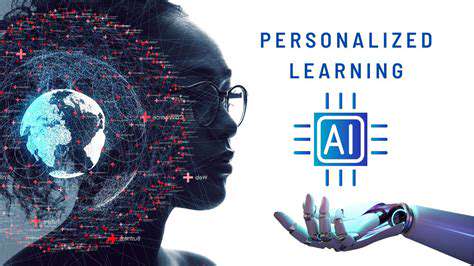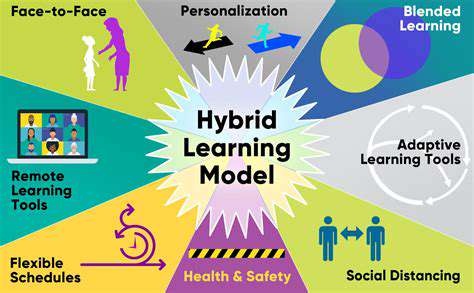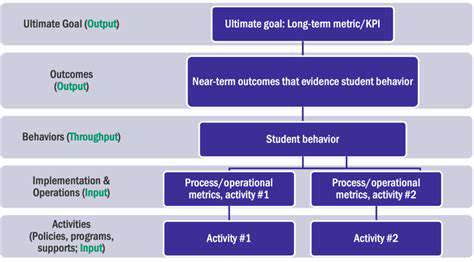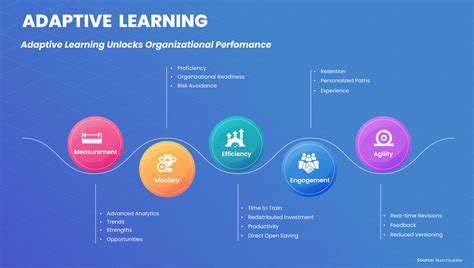Ethical AI in Education: Ensuring Fairness and Privacy
The Potential for Personalized Learning
AI's ability to analyze vast amounts of student data allows for the creation of highly personalized learning experiences. This means tailoring content, pacing, and even assessment methods to individual student needs and learning styles. Imagine a system that can identify a student struggling with a specific concept in math and immediately offer targeted practice exercises, providing immediate feedback and support. This level of individual attention can significantly improve learning outcomes and engagement.
Furthermore, AI can adapt to different learning styles, presenting information in ways that resonate most effectively with each student. Visual learners might benefit from interactive simulations, while kinesthetic learners might engage better with hands-on activities. This adaptability can bridge learning gaps and foster a more inclusive learning environment for all students.
Enhanced Accessibility and Inclusivity
AI tools can make education more accessible to students with diverse needs. For example, AI-powered tools can provide real-time captioning and translation services during lectures, making learning more accessible for students with hearing impairments or those whose first language isn't the language of instruction. This kind of accessibility can level the playing field, ensuring that all students have the opportunity to succeed.
AI-powered assistive technologies can also help students with learning disabilities, providing support in areas like note-taking, organization, and test-taking. These tools can empower students with disabilities to overcome barriers and participate fully in the learning process, promoting a more inclusive and equitable educational environment.
Automation of Administrative Tasks
AI can significantly reduce the administrative burden on educators, freeing up valuable time for them to focus on teaching and student interaction. Imagine AI systems automating tasks such as grading objective assessments, scheduling appointments, and managing student records. This automation can lead to increased efficiency and reduced workload, allowing educators to dedicate more time to personalized instruction and student support.
The Need for Ethical Considerations
While the potential benefits of AI in education are significant, careful consideration must be given to the ethical implications. Bias in AI algorithms can perpetuate existing inequalities, potentially exacerbating existing social and economic disparities. Ensuring fairness and equity in AI systems is crucial to avoid reinforcing harmful stereotypes or marginalizing certain student populations. Careful development and ongoing evaluation of AI tools are essential to ensure their equitable use across all student demographics.
Addressing Data Privacy and Security
The collection and use of student data by AI systems raise significant privacy and security concerns. Protecting student data from unauthorized access and misuse is paramount. Robust data protection measures, coupled with transparent data policies, are essential to build trust and ensure that student information is handled responsibly and ethically. Establishing clear guidelines regarding data storage, usage, and access control is critical to maintaining student privacy and security within the AI-powered learning environment.
Ensuring Fairness in AI-Powered Educational Tools

Bias Mitigation Strategies in AI Education Systems
AI-powered educational platforms have the potential to revolutionize learning experiences, offering personalized and adaptive instruction. However, the inherent risk of bias in the algorithms powering these systems poses a significant challenge. To ensure equitable access to quality education for all students, developers must implement rigorous bias mitigation strategies. These strategies should include meticulous data collection and analysis to identify and correct biases present in the training data. Careful consideration of diverse learning styles and needs is crucial to prevent the perpetuation of existing inequalities.
Bias can manifest in various forms, impacting different aspects of the learning experience. For example, algorithms might inadvertently favor students from certain socioeconomic backgrounds or with particular learning styles. Addressing these biases requires a multifaceted approach, encompassing not only the algorithms themselves but also the data used to train them. By understanding the potential sources of bias, educators and developers can proactively implement measures to promote fairness and inclusivity.
The Importance of Diverse Datasets in AI Education
The success of any AI-powered educational system hinges significantly on the quality and diversity of the datasets used to train the algorithms. Data that accurately reflects the varied experiences and needs of all learners is essential to avoid perpetuating existing biases. This requires careful consideration of factors such as cultural background, socioeconomic status, and learning styles when constructing the dataset. Using diverse datasets will help ensure that the AI system can accurately assess and cater to the specific needs of each student.
Failing to include diverse representation can lead to skewed results, potentially disadvantaging certain student groups. To prevent this, developers should actively solicit input from diverse communities and ensure that the data truly reflects the spectrum of learners. This proactive approach is crucial to prevent the perpetuation of existing inequalities and promote fairness in AI-powered education.
Transparency and Accountability in AI-Driven Educational Platforms
The design and implementation of AI-powered educational tools must prioritize transparency and accountability. Users, educators, and students should have access to clear explanations of how the system functions and why specific decisions are made. This transparency fosters trust and allows for meaningful evaluation of the system's effectiveness and fairness. Open communication and collaboration between developers, educators, and students are essential to ensure the responsible and equitable use of AI in education.
Accountability mechanisms should be in place to address any identified biases or issues. This includes clear processes for reporting discrepancies, providing feedback on the system's performance, and making necessary adjustments to ensure equitable outcomes. Furthermore, regular audits of the system's performance are critical to identify and rectify potential biases as they emerge.
Protecting Student Data Privacy: A Critical Component
Protecting Student Data Privacy: Why It Matters
In the ever-evolving landscape of education, the digital realm plays an increasingly significant role. From online learning platforms to personalized learning tools, students are generating and interacting with vast amounts of data. This data, containing sensitive information about students' academic performance, learning styles, and even personal details, necessitates a robust and ethical approach to data protection. Failing to safeguard this data can lead to serious consequences, including identity theft, discrimination, and violations of fundamental rights.
Protecting student data privacy is not just a matter of legal compliance; it's a moral imperative. It fosters trust between students, educators, and institutions, enabling a more positive and productive learning environment. When students feel their privacy is respected, they are more likely to participate actively in learning, engage with digital tools, and develop a healthy relationship with technology.
Data Minimization and Purpose Limitation
A crucial aspect of protecting student data is the principle of data minimization. This involves collecting only the data absolutely necessary to achieve specific educational goals. Schools should meticulously define the purposes for collecting student data and ensure that any collected information is directly relevant to those purposes. Unnecessary data should be avoided to limit potential risks and maintain a focus on the student's learning experience.
Furthermore, the principle of purpose limitation dictates that data should be used only for the stated purposes. Schools must establish clear policies regarding data usage and ensure that data is not misused or transferred to unauthorized parties. This strict adherence to the intended use of data is essential to prevent unintended consequences and maintain trust.
Transparency and Informed Consent
Students and their parents/guardians must be fully informed about how their data is collected, used, and protected. Clear and concise privacy policies, readily accessible to all stakeholders, are essential. These policies should outline the specific types of data collected, the purposes for which it will be used, and the procedures for accessing, correcting, or deleting data.
Moreover, obtaining informed consent from students and parents/guardians is paramount. This consent should be explicit, voluntary, and easily understood. It should clearly outline the implications of data collection and use, allowing individuals to make informed decisions about their personal information.
Data Security Measures and Ethical Considerations
Robust data security measures are essential to protect student data from unauthorized access, use, disclosure, alteration, or destruction. Schools must implement strong encryption protocols, multi-factor authentication, and regular security audits to safeguard sensitive information. Furthermore, data should be stored securely and access to it should be restricted to authorized personnel.
Ethical AI in Education and Data Privacy
The integration of artificial intelligence (AI) in education raises unique challenges regarding data privacy. AI systems often rely on vast amounts of student data to personalize learning experiences and identify potential needs. Therefore, schools must prioritize the ethical use of AI, ensuring that AI algorithms do not perpetuate biases or discriminate against students. This requires careful consideration of the potential biases inherent in the data used to train AI models, as well as ongoing monitoring and evaluation of their impact on students.
Ensuring transparency in the functioning of AI systems and establishing clear guidelines for their use in educational settings is essential. By prioritizing ethical considerations, educators can harness the benefits of AI while safeguarding student data privacy and promoting fairness and equity.
The Role of Educators in Navigating the Ethical Landscape
The Importance of Ethical Awareness
Educators play a crucial role in fostering ethical awareness in students, equipping them with the critical thinking skills necessary to navigate the complex ethical dilemmas presented by artificial intelligence (AI) in education. This involves more than just teaching about AI; it's about integrating ethical considerations into the curriculum, fostering discussions about the potential benefits and risks of AI tools, and encouraging students to develop their own ethical frameworks for evaluating the use of technology in their lives. Promoting responsible technology use, including AI, is paramount for preparing students for a future where AI is increasingly integrated into various aspects of society.
Cultivating a classroom environment where ethical discussions are encouraged and valued is essential. Students should feel comfortable expressing their opinions and concerns regarding AI's impact on learning and society. This fosters critical thinking skills and empowers students to become active participants in shaping the future of AI in education. By engaging in open dialogue and exploring different perspectives, students can develop a deeper understanding of the ethical implications of AI and learn to approach these issues with empathy and respect for diverse viewpoints.
Integrating Ethical Frameworks into Curriculum
Educators can effectively integrate ethical frameworks into the curriculum by embedding ethical considerations into existing subjects. For example, in history classes, students can analyze how technological advancements have impacted societal values and norms throughout history. In math or science classes, students can examine the potential societal impacts of AI-driven solutions, considering issues of fairness, bias, and access. By weaving ethical considerations into existing subjects, educators can create a more holistic understanding of the relationship between technology and society.
This approach can involve the use of case studies, real-world examples, and scenario-based learning activities. Presenting students with various perspectives and viewpoints on ethical issues related to AI will encourage critical thinking and the development of well-reasoned opinions. This active engagement will help students understand the complexities of ethical decision-making in a technology-driven world. Moreover, it will encourage them to consider the potential long-term consequences of their choices and actions.
Promoting Critical Thinking and Media Literacy
Educators have a critical role to play in fostering critical thinking skills related to AI in education. This means helping students evaluate information critically and identify potential biases in AI-generated content. Equipping students with the ability to discern credible sources from misinformation is essential in an era where AI-powered tools can produce convincing but potentially misleading content. It's crucial to teach students to question the source, analyze the methodology, and consider the potential biases embedded in AI systems. Engaging with news articles, social media posts, and other online resources that use AI is an important first step.
Promoting media literacy is vital. Students need to develop the ability to analyze and evaluate information presented to them through various media channels, including those utilizing AI. This includes understanding how AI algorithms can influence content selection and presentation. This crucial skill will equip students to be discerning consumers of information and avoid being misled by potentially biased or misleading content generated by AI systems. The ability to critically evaluate information is crucial for navigating the ethical landscape of AI in education.
Guiding Students in Responsible AI Use
Educators are not only responsible for teaching about the ethical implications of AI, but also for guiding students in developing responsible AI use habits. This involves demonstrating responsible practices in their own use of AI tools and technologies, setting clear expectations for student conduct, and encouraging the development of ethical decision-making skills. This is paramount for ensuring that students understand the importance of using AI tools in a responsible and ethical manner. This includes understanding the potential for bias in algorithms and the importance of ensuring equitable access to AI-powered educational resources.
Establishing clear guidelines and expectations for the use of AI tools in the classroom and beyond is essential. This should include expectations for data privacy, intellectual property rights, and responsible sharing of information. It's crucial to establish a culture where students feel empowered to raise concerns and ask questions about the ethical implications of AI. This environment of open discussion and responsible use will set students on a path to becoming ethical and responsible users of AI technology.
Building a Future of Ethical AI in Education

Defining Ethical AI
Ethical AI encompasses the development and deployment of artificial intelligence systems that align with human values and principles. This involves considering the potential societal impacts of AI, ensuring fairness, transparency, and accountability in its design and operation. A key aspect is mitigating bias in algorithms and data sets, ensuring that AI systems do not perpetuate or amplify existing societal inequalities. Furthermore, ethical AI aims to establish frameworks for responsible innovation, promoting public trust and engagement in the development of AI technologies.
Ethical considerations are paramount in the development of AI applications across various sectors, from healthcare and finance to transportation and law enforcement. Understanding and addressing these concerns proactively is crucial for building a future where AI benefits all of humanity.
Data Privacy and Security
Protecting user data is critical in an AI-driven world. Robust data privacy policies and security measures are essential to safeguard sensitive information from unauthorized access and misuse. This involves implementing strong encryption techniques, secure data storage protocols, and stringent access controls. Data anonymization and pseudonymization techniques can further enhance privacy protection.
Transparency in data usage is also vital. Users should have clear and accessible information about how their data is being collected, used, and shared by AI systems. Providing users with control over their data and allowing them to opt out or correct inaccuracies is crucial for maintaining trust and accountability.
Bias Mitigation in AI Algorithms
AI algorithms are trained on data, and if that data reflects existing societal biases, the algorithms will likely perpetuate and even amplify those biases. Identifying and mitigating these biases is crucial for ensuring fairness and equity in AI systems. This involves careful data curation, algorithm design, and ongoing monitoring and evaluation to detect and correct biases as they emerge.
Techniques for bias detection and mitigation include diverse datasets, algorithm auditing, and human oversight. By actively addressing bias, we can ensure that AI systems are not reinforcing harmful stereotypes or discriminating against certain groups. It's an ongoing process requiring continuous refinement and adaptation.
Accountability and Transparency
Establishing clear lines of accountability for AI systems is essential. Who is responsible when an AI system makes a mistake or causes harm? Defining roles and responsibilities, creating mechanisms for redress, and establishing clear standards for AI development and deployment are critical elements. Transparency in AI decision-making processes is also crucial for building trust and understanding. Making the algorithms and their decision-making processes understandable to humans is a key step in holding developers accountable and allowing for independent evaluation.
This includes providing clear explanations for AI-driven decisions, allowing for human review and intervention when necessary, and promoting open dialogue about the societal implications of AI. Transparency fosters accountability and empowers individuals to understand and navigate the impact of AI in their lives.
Human-Centered AI Design
AI should be designed with humans in mind, focusing on creating systems that augment and enhance human capabilities, rather than replacing them. Considering the needs and perspectives of diverse user groups in the design process is essential. This requires incorporating human factors, user experience principles, and ethical considerations into every stage of AI development.
Prioritizing human well-being and societal benefit is paramount in the development and deployment of AI. This includes considering the potential impact on employment, the economy, and social structures. Human-centered AI design ensures that technology serves human needs and promotes a more just and equitable society.
Read more about Ethical AI in Education: Ensuring Fairness and Privacy
Hot Recommendations
- The Gamified Parent Teacher Conference: Engaging Stakeholders
- Gamification in Education: Making Learning Irresistibly Fun
- The Future of School Libraries: AI for Personalized Recommendations
- EdTech and the Future of Creative Industries
- Empowering Student Choice: The Core of Personalized Learning
- Building Community in a Hybrid Learning Setting
- VR for Special Education: Tailored Immersive Experiences
- Measuring the True Value of EdTech: Beyond Adoption Rates
- Addressing Digital Divide in AI Educational Access
- Preparing the Workforce for AI Integration in Their Careers











